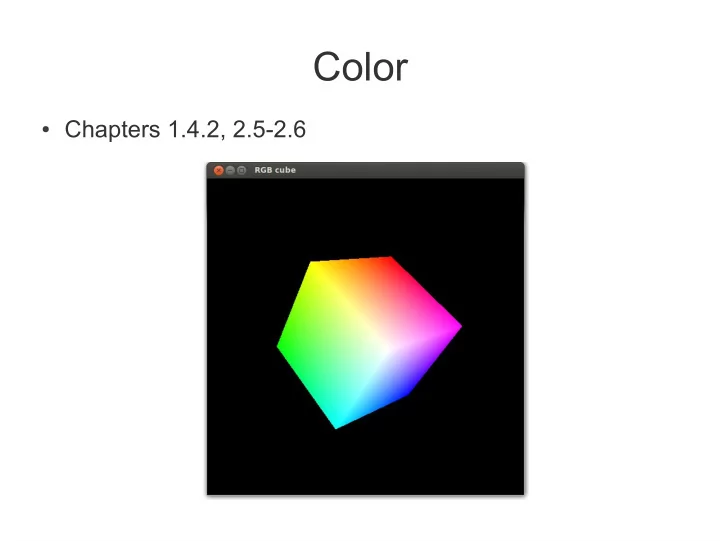

Color ● Chapters 1.4.2, 2.5-2.6
The human visual system ● The human eye has two types of light sensors: rods and cones. ● Rods sense luminance, or ”brightness”, but not color. They have slower response time than cones but are about 100 times more sensitive to light. ● There are three types of cones: S, blue-sensitive M, green-sensitive L, red-sensitive
The RGB/CMY color space ● RGB ( R ed G reen B lue): for additive color mixing, e.g., on a computer display ● CMY ( C yan M agenta Y ellow): for subtractive color mixing, e.g., in printing [C, M, Y] = [1, 1, 1] – [R, G, B] Note: Color values in OpenGL range from 0-1, not 0-255 Image source: wikimedia
Additive vs. subtractive color mixing R + G + B = white (additive) C + M + Y = black (subtractive)
RGB in computer displays ● A display system such as a LCD monitor uses only 3 primary colors (red, green, and blue) to display nearly all colors in the visible spectrum ● Each pixel is composed of three tiny light sources (one for each primary color and cone type). When viewed at a distance, these separate light sources will blend together to a solid color Individual pixel
True-color framebuffer ● Store RGB values directly in the framebuffer ● Typically, a pixel is represented with 24 bits: 8 for red, 8 for green, and 8 for blue ● A 24-bit framebuffer can represent 2^24 (16 million) simultaneous colors, which is enough for most applications ● Standard in modern graphics systems
The HSV/HSL color spaces ● Decouple intensity from color information ● Three components: ▬ H ue (angle) ▬ S aturation (radius) ▬ V alue, L ightness (height) Image source: wikimedia
RGB vs. HSV R G RGB B S H HSV V
Choosing color space ● OpenGL and GLSL assumes that colors are represented as RGB or RGBA values ● Converting RGB colors to HSV/HSL can useful for, e.g., toon shading and other image-based postprocessing effects where you want to decouple intensity from color ● You can use HSV and other non-RGB color spaces internally in your application program, as long as you convert the resulting colors back to RGB before rendering ● Regardless of which color space is used in the application, RGB is the norm in modern displays
Gamma correction ● Compensates for the non-linear response of LCD/CRT monitors ● See assignment 3, part 1
Recommend
More recommend